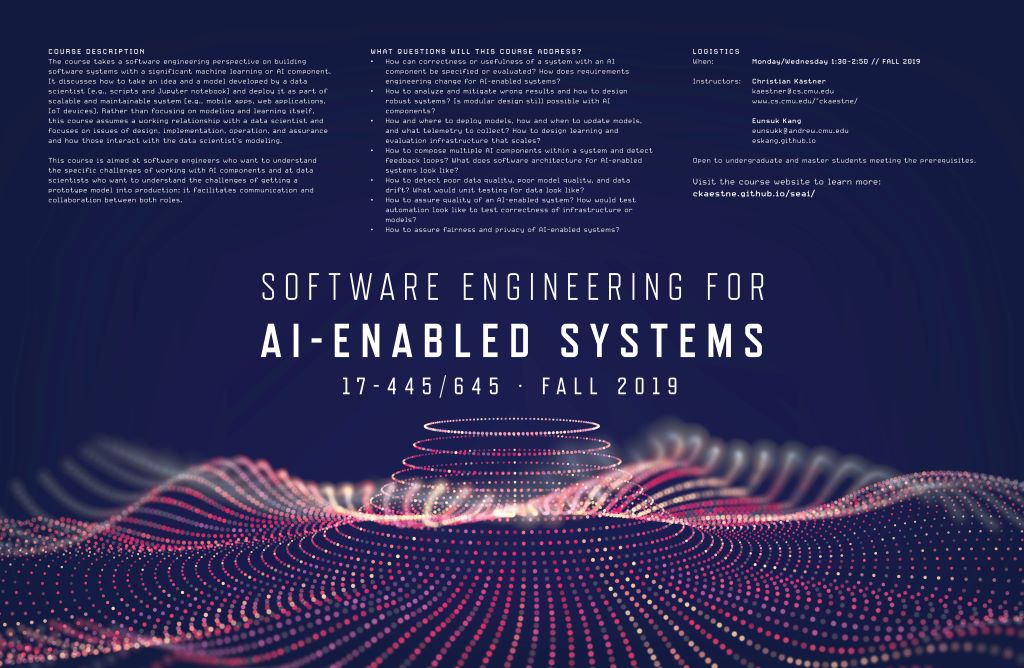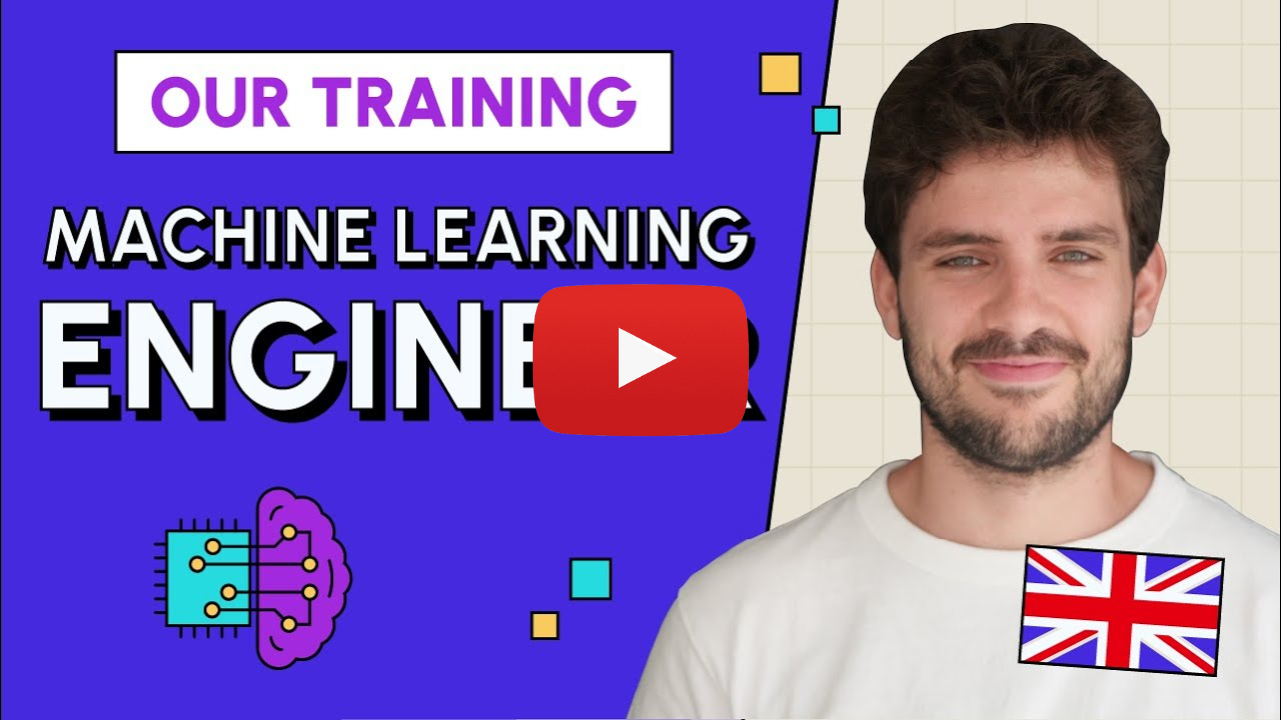All Categories
Featured
Table of Contents
- – All About What Is A Machine Learning Engineer ...
- – The Only Guide to Fundamentals Of Machine Lear...
- – About How To Become A Machine Learning Engine...
- – Top Guidelines Of Is There A Future For Softw...
- – How To Become A Machine Learning Engineer & ...
- – What Does Best Online Machine Learning Cours...
- – The Only Guide for Leverage Machine Learning...
Some people assume that that's dishonesty. Well, that's my entire career. If somebody else did it, I'm going to use what that individual did. The lesson is placing that apart. I'm compeling myself to analyze the feasible options. It's more regarding taking in the material and attempting to use those ideas and less about locating a collection that does the work or finding somebody else that coded it.
Dig a little bit deeper in the math at the beginning, simply so I can construct that structure. Santiago: Finally, lesson number 7. This is a quote. It states "You have to recognize every detail of an algorithm if you wish to use it." And afterwards I claim, "I believe this is bullshit recommendations." I do not believe that you have to understand the nuts and screws of every formula before you utilize it.
I would have to go and examine back to actually obtain a much better intuition. That does not indicate that I can not address things utilizing neural networks? It goes back to our arranging example I assume that's simply bullshit suggestions.
As a designer, I have actually dealt with several, lots of systems and I have actually used lots of, several things that I do not understand the nuts and screws of exactly how it functions, although I comprehend the influence that they have. That's the final lesson on that particular thread. Alexey: The funny point is when I think regarding all these libraries like Scikit-Learn the algorithms they use inside to apply, as an example, logistic regression or something else, are not the exact same as the algorithms we research in artificial intelligence courses.
All About What Is A Machine Learning Engineer (Ml Engineer)?
Even if we tried to discover to obtain all these basics of device learning, at the end, the algorithms that these collections utilize are different. Santiago: Yeah, absolutely. I believe we require a whole lot more materialism in the market.

By the means, there are two different paths. I generally talk to those that desire to function in the industry that wish to have their impact there. There is a path for scientists which is entirely various. I do not attempt to mention that since I do not know.
Right there outside, in the sector, pragmatism goes a lengthy way for certain. Santiago: There you go, yeah. Alexey: It is a great inspirational speech.
The Only Guide to Fundamentals Of Machine Learning For Software Engineers
Among the points I wished to ask you. I am taking a note to discuss progressing at coding. Yet first, let's cover a number of things. (32:50) Alexey: Let's begin with core devices and structures that you require to learn to really shift. Let's claim I am a software program designer.
I know Java. I recognize SQL. I understand just how to utilize Git. I understand Celebration. Maybe I understand Docker. All these things. And I become aware of device knowing, it looks like a great point. So, what are the core devices and structures? Yes, I watched this video and I get persuaded that I do not need to get deep right into mathematics.
What are the core tools and structures that I require to learn to do this? (33:10) Santiago: Yeah, absolutely. Great question. I assume, primary, you must start discovering a little of Python. Since you currently recognize Java, I don't think it's going to be a substantial change for you.
Not due to the fact that Python is the same as Java, however in a week, you're gon na obtain a whole lot of the differences there. Santiago: After that you obtain specific core tools that are going to be made use of throughout your entire profession.
About How To Become A Machine Learning Engineer (2025 Guide)
That's a collection on Pandas for data adjustment. And Matplotlib and Seaborn and Plotly. Those three, or one of those 3, for charting and showing graphics. You obtain SciKit Learn for the collection of equipment discovering algorithms. Those are tools that you're mosting likely to need to be making use of. I do not recommend just going and learning more about them unexpectedly.
Take one of those courses that are going to begin presenting you to some troubles and to some core ideas of device understanding. I don't keep in mind the name, however if you go to Kaggle, they have tutorials there for free.
What's excellent about it is that the only demand for you is to know Python. They're going to provide a problem and tell you exactly how to use decision trees to fix that particular problem. I assume that procedure is very effective, because you go from no machine finding out background, to understanding what the issue is and why you can not solve it with what you know right now, which is straight software engineering methods.
Top Guidelines Of Is There A Future For Software Engineers? The Impact Of Ai ...
On the various other hand, ML engineers focus on building and releasing device understanding versions. They concentrate on training versions with information to make forecasts or automate jobs. While there is overlap, AI engineers handle more diverse AI applications, while ML designers have a narrower focus on artificial intelligence algorithms and their practical implementation.

Artificial intelligence engineers focus on creating and releasing artificial intelligence designs into production systems. They work with design, ensuring versions are scalable, effective, and integrated right into applications. On the various other hand, data researchers have a more comprehensive duty that consists of data collection, cleansing, expedition, and building designs. They are often in charge of removing insights and making data-driven decisions.
As organizations increasingly embrace AI and machine discovering modern technologies, the demand for proficient specialists grows. Artificial intelligence engineers service innovative jobs, add to technology, and have competitive wages. Nevertheless, success in this area calls for constant understanding and staying on top of developing modern technologies and strategies. Device discovering roles are typically well-paid, with the capacity for high earning capacity.
ML is essentially various from traditional software program development as it focuses on teaching computer systems to pick up from data, instead than shows specific guidelines that are executed systematically. Uncertainty of results: You are probably utilized to composing code with foreseeable outcomes, whether your feature runs once or a thousand times. In ML, nonetheless, the results are much less certain.

Pre-training and fine-tuning: Exactly how these versions are educated on large datasets and then fine-tuned for particular tasks. Applications of LLMs: Such as message generation, view evaluation and information search and retrieval.
How To Become A Machine Learning Engineer & Get Hired ... - The Facts
The ability to handle codebases, merge adjustments, and deal with problems is equally as vital in ML development as it remains in conventional software program tasks. The skills established in debugging and screening software applications are highly transferable. While the context may change from debugging application reasoning to determining problems in data handling or version training the underlying concepts of organized examination, theory screening, and repetitive improvement are the exact same.
Machine discovering, at its core, is greatly reliant on data and chance concept. These are essential for comprehending exactly how formulas learn from data, make predictions, and assess their performance.
For those curious about LLMs, a thorough understanding of deep learning styles is valuable. This consists of not only the mechanics of neural networks however likewise the architecture of particular models for various use cases, like CNNs (Convolutional Neural Networks) for photo handling and RNNs (Frequent Neural Networks) and transformers for consecutive information and all-natural language handling.
You need to understand these problems and find out strategies for determining, mitigating, and interacting about predisposition in ML models. This consists of the prospective effect of automated decisions and the ethical effects. Numerous models, especially LLMs, require significant computational resources that are usually given by cloud systems like AWS, Google Cloud, and Azure.
Building these skills will not just assist in an effective shift into ML yet additionally make certain that developers can contribute effectively and responsibly to the development of this vibrant area. Theory is vital, however nothing beats hands-on experience. Beginning working with jobs that allow you to apply what you have actually found out in a useful context.
Develop your tasks: Start with straightforward applications, such as a chatbot or a message summarization device, and progressively raise complexity. The field of ML and LLMs is rapidly developing, with new innovations and technologies arising frequently.
What Does Best Online Machine Learning Courses And Programs Do?
Contribute to open-source projects or create blog posts about your learning trip and projects. As you acquire know-how, start looking for opportunities to include ML and LLMs right into your job, or look for new roles focused on these innovations.

Potential usage instances in interactive software, such as recommendation systems and automated decision-making. Recognizing unpredictability, standard analytical measures, and possibility distributions. Vectors, matrices, and their role in ML formulas. Mistake minimization techniques and gradient descent described simply. Terms like model, dataset, attributes, tags, training, inference, and recognition. Data collection, preprocessing strategies, version training, analysis processes, and release considerations.
Decision Trees and Random Woodlands: User-friendly and interpretable models. Matching trouble kinds with ideal models. Feedforward Networks, Convolutional Neural Networks (CNNs), Frequent Neural Networks (RNNs).
Data circulation, improvement, and attribute engineering methods. Scalability principles and efficiency optimization. API-driven approaches and microservices integration. Latency management, scalability, and variation control. Continual Integration/Continuous Deployment (CI/CD) for ML operations. Model tracking, versioning, and performance tracking. Detecting and dealing with modifications in model performance gradually. Dealing with efficiency traffic jams and resource management.
The Only Guide for Leverage Machine Learning For Software Development - Gap

You'll be introduced to 3 of the most pertinent elements of the AI/ML self-control; supervised learning, neural networks, and deep knowing. You'll realize the distinctions between traditional programming and maker learning by hands-on development in supervised understanding before constructing out complex distributed applications with neural networks.
This course offers as an overview to machine lear ... Program Much more.
Table of Contents
- – All About What Is A Machine Learning Engineer ...
- – The Only Guide to Fundamentals Of Machine Lear...
- – About How To Become A Machine Learning Engine...
- – Top Guidelines Of Is There A Future For Softw...
- – How To Become A Machine Learning Engineer & ...
- – What Does Best Online Machine Learning Cours...
- – The Only Guide for Leverage Machine Learning...
Latest Posts
How To Create A Study Plan For A Software Engineering Technical Interview
The Best Youtube Channels For Coding Interview Preparation
Netflix Software Engineer Interview Guide – Insider Advice
More
Latest Posts
How To Create A Study Plan For A Software Engineering Technical Interview
The Best Youtube Channels For Coding Interview Preparation
Netflix Software Engineer Interview Guide – Insider Advice